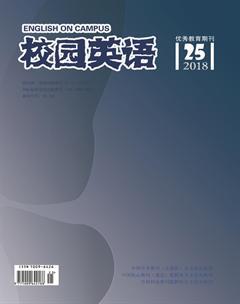A Conceptual Metaphorical Analysis of Linguistic Sexism in Chinese and English
【Abstract】With qualitative and comparison methods, this study aims to make a comparison of metaphors between Chinese and English to reveal the common cognitive causes of linguistic sexism, help language users aware of these discriminatory expressions.
【Key words】linguistic sexism; metaphor; comparison
【作者简介】陆艳,南通大学外国语学院。
I. Introduction
As a sort of cultural medium, Linguistic sexism naturally reflects the thoughts and opinions of human beings as well as their social values. Cognitive linguistics provides new approaches for this subject because the inner mechanism directly affects the formation of their language. Based on the Conceptual Metaphor Theory (Lakoff & Johnson,1980), this study aims to make a comparison between Chinese and English to reveal the common cognitive causes of linguistic sexism, help language users aware of these discriminatory expressions in a different angle.
II. Cognitive analysis of linguistic sexism in Chinese and English
1.Metaphor: woman is food. People use different foods characteristics in taste and sight with womens attraction in features and sex due to the shared attributes such as “beautiful” “sexy” “prostitute”. “My sweet” and “小辣椒” belongs to seasoning domain, implying women who are lovely or easily irritated. We can find “delicious women” “秀色可餐” both in English and Chinese which means women are good looking. Similarly, “meat” both in Chinese “賣肉” and English “fresh meat” implies the prostitutes trade with bias.
2.Metaphor: woman is a flower. Generally speaking, women are named after flowers symbolise purity, kindness, gentleness, beauty, such as “Daisy”“兰”. But people did not ignore the flower is the reproductive organs of plants.
3.Metaphor: Woman is goods. In English and Chinese, it is also customary to refer to women in terms of goods or articles. Whether in the west or in China, women are regarded as goods or property which can be arbitrarily “sold” or “ lost”.
4.Metaphor: woman is an animal. In English and Chinese, many animal words are used to metaphor women. In summary. The sentences such as “一个女人抵得上五百只鸭子”, “她真是个可怜的小羔羊”, “Three women and a goose make a market”, “Mary is a sexy kitten” prove womens ignorance and helplessness, strengthening the female appearance of sexy highlights which is the only sexual attraction for man, belittling or demonizing women.
5.Metaphor: woman is a part of man. The last name like “Mrs. Trump”“贾夫人” and professional names like “madam chairman” “女总理” shows women belong and belittle to men. Besides, in Chinese and English, men are placed in the first place, such as “husband and wife”“夫唱妇随”reflects the male dominance, active status, the subordinate and passive status of women. The generalization of he and他们indicates that she and 她们are hidden. And man can represent both men and all mankind when it comes to women, it must be expressed in woman. All the examples entail the metaphor: woman is a part of man.
III. Interpretation with cognitive metaphor theory
The conceptual metaphor mentioned above achieves the metaphorical cognitive effect through iconicity. Cognitive metaphor construction is based on iconicity. There is an inevitable link between the form and content of language, that is, the relationship between the two can be demonstrated, is justified. (Zhao Yanfang, 2004) In addition, our values must be in consistent with the metaphorical conceptual system which we live by. Tracing back to the history, the quotes as follow from Ancient Chinese and English classics illustrate the values of thousands years deeply rooted in peoples minds determine the way of thinking and expressing. “夫為妻纲”(husband guides wife)from Liwei; in Bible, when God created Eve with Adams rib, Eve was destined to be the vassal of Adam.
IV. Conclusion
Due to the cognitive construction of social, historical and cultural experience and iconicity, there exists the shared and independent based sexist expressions in Chinese and English. Both in Chinese and in English, a large number of metaphorical words, terms and expressions reveal that the society holds double standards on evaluating men and women. They regard women as something inferior to humans. However, there are unique linguistic forms of the two languages as means of metaphorical expressions demonstrating bias embodied in humans mind between the two languages.
References:
[1]G LAKOFF,M.JOHNSON.Metaphors We Live By[M].Chicago: University of Chicago Press,1980.

